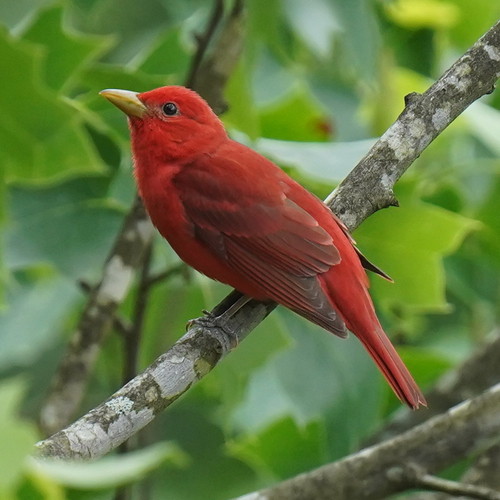
Summer Tanager
The Summer Tanager (Piranga rubra) is a medium-sized American songbird known for its vibrant plumage and distinctive calls. Unlike most tanagers, which are tropical, the Summer Tanager breeds in temperate North America and migrates to Central and South America for the winter. It plays a significant ecological role as an insectivore, particularly specializing in catching bees and wasps. While not holding specific cultural significance in many areas, its bright coloration and lively presence make it a favorite among birdwatchers.
17-19 cm
Length
28-30 cm
Wingspan
Least Concern
Conservation Status
Distribution
Breeds across the southern and eastern United States, extending from California in the southwest to New Jersey in the northeast. Winters in Mexico, Central America, and northern South America, as far south as Bolivia and Brazil. Migratory routes vary but generally follow a broad front across the Gulf of Mexico.
Lifespan
Up to 5 years in the wild; longer lifespans have been recorded in captivity (exact records vary).
Summer Tanager's Habitat
Habitat Types
Open woodlands, Forest edges, Riparian corridors, Parks with mature trees
Climate Zones
Temperate, Subtropical, Tropical
Adaptations
Their relatively large bill is adapted for catching and handling flying insects, particularly bees and wasps. They have also shown behavioral adaptations to avoid stings, such as rubbing the insects against branches to remove the stinger before consumption.
Variations
Two subspecies are generally recognized: *P. r. rubra* (eastern) and *P. r. cooperi* (western). The western subspecies tends to be slightly larger and paler.
Appearance
Breeding Plumage
Adult males in breeding plumage are entirely bright red. Females and immature males are olive-yellow above and brighter yellow below. Non-breeding males may have patches of red and yellow.
Seasonal Feather Changes
Males undergo a molt after breeding, resulting in a more subdued, patchy red and yellow plumage during the winter. They regain their full red plumage before the next breeding season.
Sex Based Plumage Differences
Strong sexual dimorphism in plumage, with males being bright red and females olive-yellow.
Notable Features
Bright red plumage in adult males, Relatively thick, pointed bill, Dark eyes
Diet and Feeding
Primary Foods
Bees, Wasps, Other flying insects, Beetles, Spiders, Fruits (especially during migration and winter)
Foraging Behavior
Often forages high in the canopy, sallying out to catch flying insects. Also known to glean insects from leaves and branches. Will sometimes descend to lower levels or even the ground to forage.
Specializations
Specialized behavior for handling bees and wasps, including removing stingers before consumption.
Seasonal Diet Variations
Diet shifts to include more fruits during migration and on the wintering grounds when insects are less abundant.
Behavior
Social Structure
Generally solitary or found in pairs during the breeding season. May form small flocks during migration and on the wintering grounds.
Communication
A distinctive, robin-like song, often described as 'chick-burr' or 'pi-tuk-a-tuk', Various call notes, including a sharp 'pit-i-tuck'
Migration
Complete migrant, traveling between North American breeding grounds and wintering areas in Central and South America. Migrates at night.
Territorial or Group Behaviors
Males defend breeding territories through song and aggressive displays. Territoriality is less pronounced during migration and winter.
Conservation
Threats
Habitat loss and fragmentation on both breeding and wintering grounds, Pesticide use, particularly those impacting insect populations, Collisions with buildings and other structures during migration
Protection Programs
General bird conservation efforts aimed at habitat preservation, Monitoring programs like the Breeding Bird Survey
Local National Laws
Protected under the Migratory Bird Treaty Act in the United States.
Population Trend
Generally stable, although some regional declines have been noted.
Population Estimates
Global population estimated to be around 9.5 million individuals (Partners in Flight).
Interesting Facts
They are bee and wasp specialists.
Summer Tanagers have developed techniques to safely eat bees and wasps, including removing their stingers.
Males are entirely red.
This makes them stand out among North American songbirds, as most other red birds have some black markings.
They are Neotropical migrants.
This means they breed in North America and spend the winter in Central and South America.
Faqs about Summer Tanager
What do Summer Tanagers eat?
They primarily eat insects, especially bees and wasps, but also supplement their diet with fruits, particularly during migration and winter.
Where can I see a Summer Tanager?
During the breeding season, look for them in open woodlands and forest edges across the southern and eastern United States. They are more difficult to find during migration and on their wintering grounds.
Are Summer Tanagers endangered?
No, they are currently listed as a species of Least Concern by the IUCN.
How can I differentiate a male Summer Tanager from a Northern Cardinal?
While both are red, male Summer Tanagers lack the black face mask and prominent crest that characterize Northern Cardinals. Their bills are also a different shape and color; Summer Tanagers have a yellowish bill, while Cardinals have a reddish-orange one.
How long do Summer Tanagers live?
The average lifespan in the wild is thought to be around 5 years, though some individuals may live longer.
Copyright @ Nature Style Limited. All Rights Reserved.
 English
English